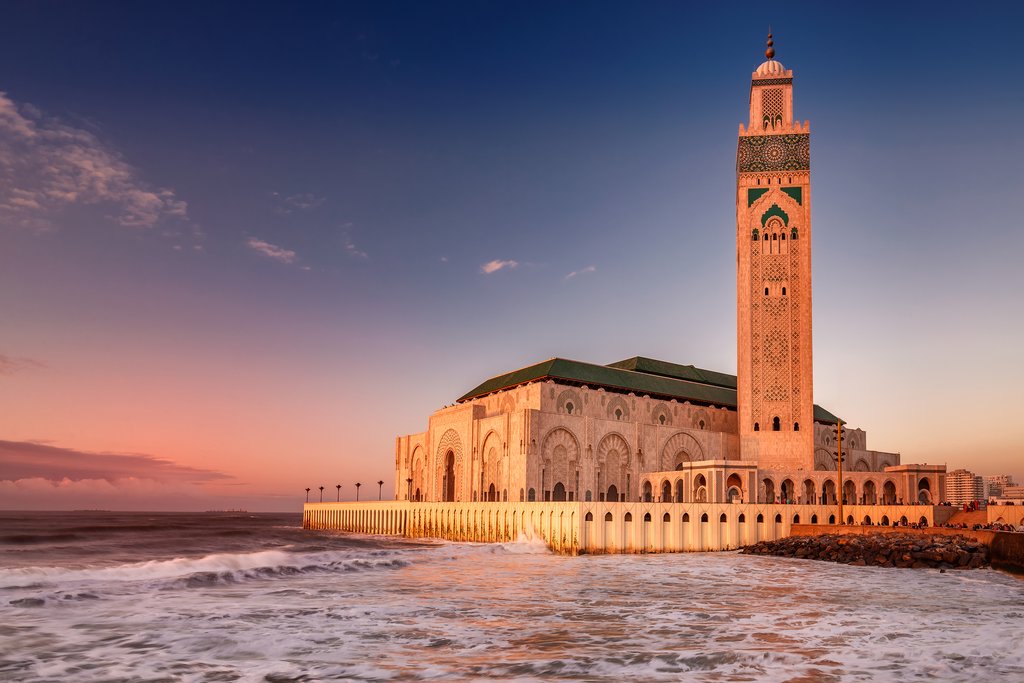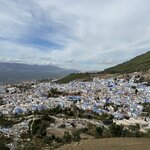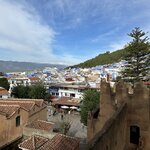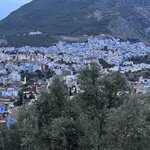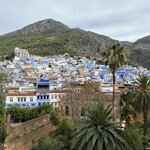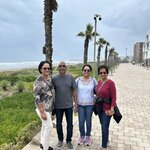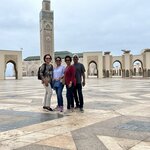Highlights
- See the famous "Blue City" of Chefchaouen
- Explore remote towns and villages in the Sahara Desert
- Wander through Marrakech's colorful medina and gardens
- Enjoy a guided tour of the breezy coastal town of Essaouira
Brief Itinerary
| Day | Highlights | Overnight |
|---|---|---|
| Day 1 | Arrive in Casablanca & Transfer to Rabat | Rabat |
| Day 2 | Explore the "Blue City" of Chefchaouen | Chefchaouen |
| Day 3 | Travel to Fes via Volubilis & Meknes | Fes |
| Day 4 | Half-Day Guided Tour of Fes Medina | Fes |
| Day 5 | Travel to Merzouga via the Middle Atlas, Midelt & Erfoud | Merzouga |
| Day 6 | Desert Safari Adventures around Merzouga | Merzouga |
| Day 7 | Drive Through the Desert to Reach Skoura | Skoura |
| Day 8 | Walk in Skoura Oasis & Have Lunch with a Local Family | Skoura |
| Day 9 | Drive to Marrakech via Ouarzazate & Aït Benhaddou | Marrakech |
| Day 10 | Half-Day of Guided Sightseeing in Marrakech | Marrakech |
| Day 11 | Travel to the Coast and Explore Essaouira | Essaouira |
| Day 12 | Guided Sightseeing Tour of Essaouira | Essaouira |
| Day 13 | Free Day in Essaouira | Essaouira |
| Day 14 | Transfer to Casablanca | Casablanca |
| Day 15 | Depart Casablanca |
Detailed Itinerary
Day 1: Arrive in Casablanca & Transfer to Rabat
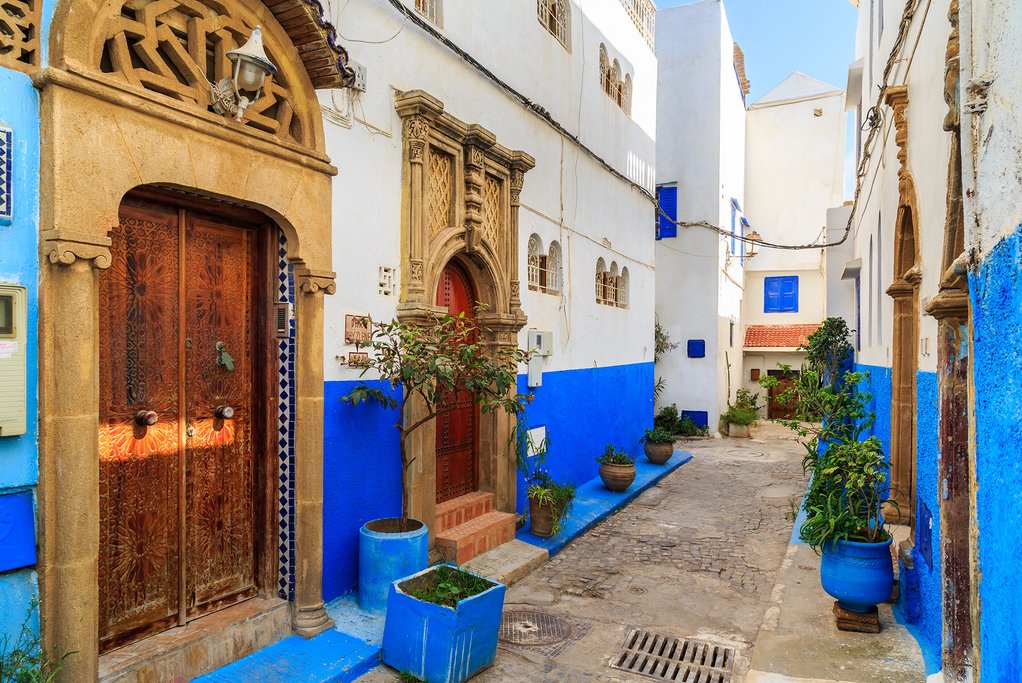
Welcome to Morocco! After flying into Casablanca, a private driver will await you at the airport and transfer you to Rabat. You'll have the rest of the day to explore this bustling city, Morocco's capital since 1956, and a UNESCO World Heritage Site since 2012.
Start at the Royal Palace and the medieval fortification of the Chellah Necropolis, where you can wander the Roman and Islamic ruins. Stroll through the medina (old town) to find the Hassan Tower and Mausoleum of Mohamed V. This abandoned 12th-century project features the minaret of an incomplete mosque and some 200 columns. Next, explore the historical medina and roam through its charming streets, stopping at the souks (markets) to peruse local crafts and goods, such as rugs, spices, slippers, jewelry, and leather.
Finally, visit the 20th-century Andalusian Gardens and enjoy the serene space away from the crowds before ending your tour at the grand door of the Kasbah des Oudaïas, the gate out of Rabat's old city center.
Day 2: Explore the "Blue City" of Chefchaouen

The next day, enjoy a comfortable private transfer from Rabat to Chefchaouen. After settling into your accommodation, head out to explore. Wander through the city's medina and its winding maze of picturesque streets while appreciating the relaxed atmosphere. The old medina has combined Moroccan and Andalusian influences noted in the red-tiled roofs, bright blue buildings, and narrow lanes connecting busy Plaza Uta el-Hammam and its restored kasbah (old fortification).
Once you've had a look around the plaza and perused the nearby souks, head toward the Grand Mosque and kasbah, where you can enjoy walking through the garden, museum, and some of the old prison cells used during Spanish rule. Next, wander into the Quartier Al Andalous, where the houses are painted white, green, and blue. End your day at Ras El Ma Spring, the town's primary water source. Here you can take a break at one of the quaint riverside cafés for a traditional cup of tea. Enjoy a sunset from the Spanish Mosque for an exceptional view of the city.
Day 3: Travel to Fes via Volubilis & Meknes

Head off on a comfortable private transfer to Fes, making a few interesting stops. First, wander through the massive Roman complex at Volubilis, exploring large merchant homes with visible heating systems, temples, and colorful mosaics. Next, continue to Meknes, the imperial city of Sultan Moulay Ismail, and stroll through its compact medina. Other than the city's scattered souks, you can also see Marinid-era architecture at the 14th-century Bou Inania Madrasa and the impressive 19th-century palace of Dar Jamaï.
Your final stop is Fes. Before settling into your traditional riad accommodation, drive up to the Marinid Tombs, a hilltop archeological site where you can enjoy a lovely panorama of the old city. On the hillside below, you may see leather drying in the sun. Then, make your way into the bustling medina and enjoy navigating Fes' charming streets. Finally, return to your riad for dinner and relaxation.
Day 4: Half-Day Guided Tour of Fes Medina

Today, you'll discover the vibrant and fortified medina of Fes, the cultural capital of Morocco, with the help of a private tour guide. First, you'll pass through the Bab Boujloud (Blue Gate), a Moorish gate with three arches acting as the old town's main entrance, and wander into the bustling souk. Next, visit the famous Chouara Tannery and the 9th-century Al-Qarawiyyin Mosque and University, the world's oldest continuously operating university.
Stop at either Bou Inania Madrasa or Al Attarine Madrasa, two 14th-century schools featuring beautiful Marinid and Moroccan architecture and zellij tiles. Then, wander to some of the other sites of Fes, such as the Mellah (Jewish District and cemetery) and the Dar el Makhzen (Royal Palace of Fes). Or check out a museum, like the Borj Nord, which features a collection of weapons and armor from several eras and incredible roof-top views. When hungry, your guide will lead you to a local eatery to taste dishes such as couscous, shakshuka, makouda (spiced battered potato cakes), and slow-roasted méchoui lamb.Day 5: Travel to Merzouga via the Middle Atlas, Midelt & Erfoud

On the way to Merzouga, stop at a few cultural spots to meet the desert communities of the Sahara. You'll have the opportunity to chat with nomadic shepherds, stroll through settlements, and, if time allows, enjoy a cup of tea with a local Berber family. As you approach Merzouga, you'll see the sand waves of Erg Chebbi—an extensive set of dunes covering almost 14 square miles (35 sq km), with some peaks rising over 650 feet (200 m).
Upon arrival, take a short break as you prepare for a camel ride through the dunes. After settling into your tent, climb up the nearest dune to watch the sunset. Head back to camp for dinner and a night by the campfire, enjoying traditional Berber music and savoring the stars strewn across the unhindered night sky. If modern comfort is more your style, you can always opt for a comfortable hotel or auberge in town instead.Day 6: Desert Safari Adventures around Merzouga

Chat with a local specialist who can help organize your trip.
Day 7: Drive Through the Desert to Reach Skoura

Your next stop is an impressive 984 feet (300 m) high gorge known as the Todra Gorge. You can enjoy a leisurely walk or relax in the cool shallow water. The surrounding area is known as the Valley of a Thousand Kasbahs—as you drive onward, you'll notice many kasbahs (defense fortresses) in disrepair. You'll then enter the Dades Valley, where cultivated farmland plots border fields of rose bushes. If you're here in May, you can catch the annual Rose Festival; at any other time of year, stop at the rose collective to watch the distillation process in action. Your final stop is your accommodation in the relaxing palm grove of Skoura.
Day 8: Walk in Skoura Oasis & Have Lunch with a Local Family

At lunchtime, join a family in their traditional house, and learn more about the food and history of this unique culture. End your meal with an authentic tea ceremony, then head back to your accommodation.
Day 9: Drive to Marrakech via Ouarzazate & Aït Benhaddou

Just on the edge of this quiet Moroccan city, you'll find Taourirt Kasbah, a citadel set against the backdrop of the Atlas Mountains. Next, explore the medieval kasbah of Aït Benhaddou, Morocco's most famous kasbah and a UNESCO World Heritage Site. After leaving Aït Benhaddou, you'll wind over the Atlas Mountains via the Tizi n'Tichka Pass before joining the hustle of vibrant Marrakech. Settle into your accommodation, then see Jemaa el-Fna, the city's main square, which comes alive every evening with musicians, performers, snake charmers, games, and food stalls. Wander around the square or enjoy it all from a distance at a nearby café.
Day 10: Half-Day of Guided Sightseeing in Marrakech

Experience the sights, sounds, and smells of Marrakech, known as the "Red City," on a tour led by a local guide. Start at Jemaa el-Fna Square, then stroll to a few of the best souks. You'll find the famed spice towers at Souk el Attarine and traditional Moroccan slippers at Souk Smata. Brass, silver, and other blacksmith goods are at Souk Haddadine. But don't miss Souk des Teinturiers, where you can watch locals dyeing and hanging cloth and yarn.
Your guide will lead you to the 19th-century Bahia Palace. Enjoy strolling through the courtyard's lush gardens and admiring the stunning interiors, including intricate woodwork and ornamented ceilings. Then head to Koutoubia Mosque, the city's largest mosque. Lastly, make your way slightly out of the old town to the 12th-century Menara Gardens. Once your tour is complete, spend the afternoon wandering through one of Marrakech's most special sites: Le Jardin Secret (The Secret Garden), a recently-restored 19th-century palace complex featuring traditional architecture and many different types of exotic plants.Day 11: Travel to the Coast and Explore Essaouira

Arrive in the laid-back port city of Essaouira, a nice contrast to frenetic Marrakesh, and spend the rest of the day as you choose. Walk the Skala de la Kasbah (the 18th-century seafront ramparts) along the coast. Designed by European engineers, old brass cannons line the walls and offer viewing access over the Atlantic. Explore the UNESCO-listed medina before making your way to the windswept beach. Then, walk back to Essaouira and enjoy a meal of fresh-caught seafood.
Day 12: Guided Sightseeing Tour of Essaouira

Next, you'll explore the city's Jewish history, stopping at Haim Pinto Synagogue, a historical and religious site dating to the early 18th century. Wander through the Mellah (Jewish District and a UNESCO World Heritage Site), listen to stories of Essaouira's Jewish communities, and admire the profound door paintings and carved emblems. The other two preserved synagogues include Slat Attia and Slat Lkahal Mogador. Your guide will leave you at Essaouira Beach at the end of the tour. Walk along the shoreline, soak up the sun, and catch glimpses of surfers in the wind.
Day 13: Free Day in Essaouira

Take time to soak in Essaouira's unique atmosphere and beautiful historic architecture. The city was occupied by indigenous Berbers, Phoenicians, Romans, and Portuguese, who built its fortress and ramparts in 1506. Known for its blue and white buildings, Essaouira hosts an art-centric population, attracting a sizeable bohemian crowd for the Gnawa and World Music Festival every summer. You'll also find windsurfing and kitesurfing enthusiasts, thanks to the powerful winds that constantly blow in the bay.
You can use your free day to shop for souvenirs in the souks, sample grilled sardines at the city's fish auction (which takes place in the market hall just outside the port gates), wander along the beach, or do anything else you'd like.
Day 14: Transfer to Casablanca

Day 15: Depart Casablanca

More Great Morocco Itineraries
Looking for more inspiration for your trip to Morocco? Check out these other 15-day Morocco itineraries, explore different ways to spend 15 days in Morocco, or learn about the best time to visit Morocco.
